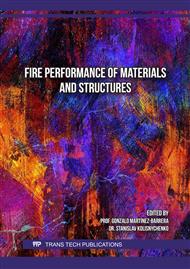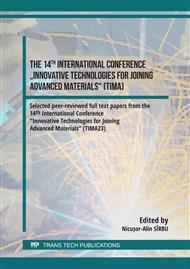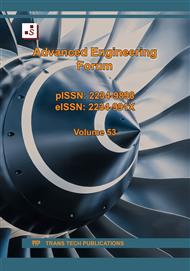[1]
Lapuebla-Ferri A., Pons D., Romero M.L.: Load and temperature influence on the post-fire mechanical properties of steel reinforcements, Journal of Constructional Steel Research 185, 106866, (2021)
DOI: 10.1016/j.jcsr.2021.106866
Google Scholar
[2]
Maraveas C., Fasoulakis Z., Tsavdaridis, K.D.: Post-fire assessment and reinstatement of steel structures, Journal of Structural Fire Engineering 8, no. 2, (2017), pp.181-201
DOI: 10.1108/JSFE-03-2017-0028
Google Scholar
[3]
Gunalan S., G., Mahendran M.: Experimental investigation of post-fire mechanical properties of cold formed steels, Thin-Walled Structures 84, (2014), pp.241-254, https://eprints.qut.edu.au/74916/
DOI: 10.1016/j.tws.2014.06.010
Google Scholar
[4]
Yujie Yu, Lifeng Lan, Faxing Ding, Liping Wang: Mechanical properties of hot-rolled and cold-formed steels after exposure to elevated temperature: A review, Construction and Building Materials 213, (2019), pp.360-376
DOI: 10.1016/j.conbuildmat.2019.04.062
Google Scholar
[5]
Sivakumar K., Mahendran M.: Post-fire mechanical properties of cold-formed steel hollow sections. Construction and Building Materials 161, (2018), pp.26-36, https://eprints.qut.edu.au/150877/
DOI: 10.1016/j.conbuildmat.2017.11.077
Google Scholar
[6]
Maraveas C., Fasoulakis Z.C., Tsavdaridis K.D.: Mechanical properties of High and Very High Steel at elevated temperatures and after cooling down, Fire Science Reviews 6, article 3, (2017)
DOI: 10.1186/s40038-017-0017-6
Google Scholar
[7]
Liu, D., Liu, X., Fu, F. et al. Nondestructive Post-fire Damage Assessment of Structural Steel Members Using Leeb Harness Method, Fire Technol 56, pp.1777-1799, (2020)
DOI: 10.1007/s10694-020-00954-6
Google Scholar
[8]
Blanc C.M., Sánchez A.O., Navarro I.F.: Evaluation of steel structures integrity in a post-fire condition: Case study of the Serradells sports centre in Andorra, Fire Safety Journal 133, (2022), 103668
DOI: 10.1016/j.firesaf.2022.103668
Google Scholar
[9]
LaMalva K., Danny Hopkin D.: International Handbook of Structural Fire Engineering, Springer International Publishing, (2021)
Google Scholar
[10]
Ali B., Dehcheshmeh E. M., Safari P., Broujerdian V., Huang S. S.: Post-fire Seismic Performance of Low-Yielding-Steel Plate Shear Wall Systems, International Journal of Civil Engineering 21 (2023), p.1661 – 1678
DOI: 10.1007/s40999-023-00856-y
Google Scholar
[11]
Miao D., Shen L., Ge Y., Yang B., Zhao M.S., Ran C.H., Chiew S.P.: Experimental study on the post-fire cyclic behavior of Q960E ultra-high-strength structural steel, Thin-Walled Structures (2023)
DOI: 10.1016/j.tws.2023.111078
Google Scholar
[12]
Jianmin H., Wang F., Xue X., Sun Y., Gao Y.: Post-fire ultra-low cycle fatigue properties of high-strength steel via different cooling methods, Thin-Walled Structures (2023)
DOI: 10.1016/j.tws.2022.110406
Google Scholar
[13]
Hongbo L., Liao X., Chen Z., Huang S.S.: Post-fire residual mechanical properties of steel butt weld - Experimental study, Journal of Constructional Steel Research 129 (2017), pp.156-162
DOI: 10.1016/j.jcsr.2016.11.004
Google Scholar
[14]
Gang S., Wang S.Q., Chen X., Rong C.: Post-fire mechanical properties of base metal and welds of Q235 steel, Journal of Constructional Steel Research 183 (2021), 106767
DOI: 10.1016/j.jcsr.2021.106767
Google Scholar
[15]
Dulce R., Leitão C., Balakrishnan M., Craveiro H.D., Santiago A.: Tensile properties of S355 butt welds after exposure to high temperatures, Construction and Building Materials 302 (2021), 124374
DOI: 10.1016/j.conbuildmat.2021.124374
Google Scholar
[16]
Balakrishnan M., Leitão C., Craveiro D.C., Rodrigues D., Santiago A., da Silva L.S., Subramanian C.: Post fire tensile properties of S355 J2 structural steel welded connections for construction industrial applications, Metallurgical Research & Technology (2022)
DOI: 10.1051/metal/2022056
Google Scholar
[17]
Yazhi Z., Huang S., Sajid H.U.: Micro-Mechanisms and Modeling of Ductile Fracture Initiation in Structural Steel after Exposure to Elevated Temperatures, Metals 11, (2021), p.767
DOI: 10.3390/met11050767
Google Scholar
[18]
Pantousa D., Karavasilis T., Maraveas C.: Numerical Investigation of the Post-Fire Performance of Steel Columns, Buildings 12, (2022), p.288, https:// doi.org/
DOI: 10.3390/buildings12030288
Google Scholar
[19]
Mina S., Weigand J.M., Main J.A., Peixoto R., Vieira C.M.: Shear behavior of high-strength bolts at elevated temperatures: testing and formulation of reduced-order model, Materials Science, (2018)
DOI: 10.6028/nist.tn.1978
Google Scholar
[20]
Mazza, F., Giovanna Imbrogno, G.: Effects of Fire Duration on the Seismic Retrofitting with Hysteretic Damped Braces of r.c. School Buildings, Front. Built Environ 5, article 141, (2019)
DOI: 10.3389/fbuil.2019.00141
Google Scholar
[21]
Qiaqia Z.: Fire behavior of bolted connections, Engineering, Purdue University, West Lafayette, Indiana (2014).
Google Scholar
[22]
Hongbo L., Dongyu L., Chen Z., Yu Y.: Post-fire residual slip resistance and shear capacity of high-strength bolted connection, Journal of Constructional Steel Research 138, (2017), pp.65-71
DOI: 10.1016/j.jcsr.2017.06.026
Google Scholar




